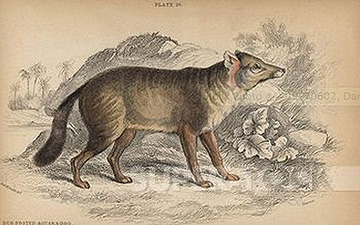Darwin’s fox or Darwin’s Zorro (Lycalopex fulvipes) is a small critically endangered canine from the genus Lycalopex. It is also known as the Zorro Chilote or Zorro de Darwin[2] in Spanish and lives on Chiloé Island and Nahuelbuta National Park in mainland Chile (Araucanía Region).
Darwin’s fox was first collected from San Pedro Island off the coast of Chile by the naturalist Charles Darwin in 1834. It was long held that Darwin’s fox was a subspecies of the South American gray fox (L. griseus); however, the discovery of a small population of Darwin’s fox on the mainland in Nahuelbuta National Park in 1990[3] and subsequent genetic analysis has clarified the fox’s status as a unique species.[4] In 2013 it was officially confirmed the presence of Darwin’s fox at Oncol Park and the Valdivian Coastal Reserve.[5]
Darwin’s fox has a vast diet. In dense forests, where it exists, the foxes hunt for mammals, reptiles, beetles, andinvertebrates. Sometimes it selects fruits and berries. Birds andamphibians to a lesser degree are also consumed. It sometimes eats carrion, but it mostly eats live animals and fruit. This makes it mostly an omnivore, sometimes a scavenger.
Darwin’s fox is generally believed to be a forest obligate species found only in southern temperate rainforests.[2] They only occur in areas of primary forest on Chiloé and on the mainland. They are most active at twilight and before sunrise.. The population of Chiloé has about 200 individuals, and Nahuelbuta on the mainland contains about 50 individuals. The total population size is about 250 mature individuals with at least 90% of the population occurring in one subspopulation (Chiloé Island). Although the species is protected in Nahuelbuta National Park, substantial mortality sources exist when foxes move to lower, unprotected private areas in search of milder conditions during the winter.[9]
It is believed that there are only 250 Darwin’s foxes on Chiloé Island and up to 70 on the mainland, and they are listed as critically endangered by the World Conservation Union.[2] Fragmentation of forest adjacent to the national park and on the island is a concern for their conservation, and feral dogs may pose the greatest threat to their survival by spreading disease or directly attacking. Persecution by people who think that the foxes attack domestic fowls, though they pose little threat, is also a potential problem.
(From Wikipedia, October 2013)



